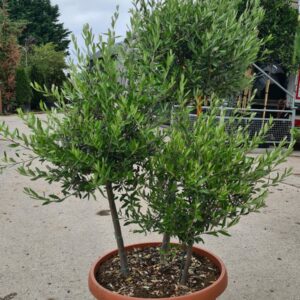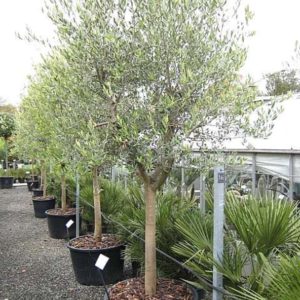Olea europaea Bonsai Shape / Olive Bonsai
€800.00
Frequently Bought Together


Description
Quick Facts
Common Name: Olive Tree – Bonsai Form
Botanical Name: Olea europaea
Mature Height: Limited by specific shape
Hardiness: Hardy to -10°C
Position: Full sun, sheltered
Botanical Name: Olea europaea
Mature Height: Limited by specific shape
Hardiness: Hardy to -10°C
Position: Full sun, sheltered
Experience the ancient art of bonsai on a grand scale with these extraordinary Bonsai Form Olive trees, where centuries-old Japanese techniques meet Mediterranean soul. Standing majestically at 160-200cm in their generous containers, each specimen tells a story of patience, artistry, and natural beauty refined to perfection. These aren’t merely potted trees – they’re living masterpieces that bring the contemplative elegance of traditional bonsai into contemporary garden spaces with dramatic, room-filling presence.
The defining feature of these remarkable specimens lies in their powerful, sculptural trunks – thick, gnarled, and full of character that speaks of age and wisdom. From these sturdy foundations emerge multiple distinctive arms, each one carefully trained and positioned to create perfect balance and harmony. Every branch culminates in dense clouds of silvery-green foliage that seem to float effortlessly in space, creating an almost ethereal quality that changes with light and season.
This unique form captures the meditative essence of traditional bonsai while offering the impact and scale perfect for modern outdoor living. The substantial trunk and architectural branching pattern create fascinating shadows and silhouettes, making these trees as beautiful in winter’s stark light as in summer’s full glory. Their container cultivation offers incredible versatility – position as a centrepiece on terraces, frame outdoor seating areas, or create dramatic entrances that welcome guests with understated luxury.
The bonsai form represents the perfect marriage of portability and presence, allowing you to redesign and refresh your outdoor spaces seasonally. These specimens work beautifully in pairs for formal symmetry, as single statement pieces in minimalist settings, or grouped with other architectural plants for contemporary Mediterranean styling. Their contained root system makes them ideal for roof gardens, courtyards, or any space where permanent planting isn’t possible but maximum impact is desired.
Caragh Garden Notebook: Maintain in large, well-draining containers with quality compost mixed with horticultural grit. Water regularly during growing season, allowing slight drying between waterings – container plants need more frequent attention than ground-planted specimens. Feed monthly with balanced liquid fertiliser from spring through early autumn. The bonsai form requires careful annual pruning in late spring; trim new growth to maintain the dense foliage clouds while preserving the architectural branch structure. Pinch growing tips regularly during the growing season to encourage density. Protect from harsh winter winds and consider moving to sheltered positions during extreme cold. Repot every 3-4 years or when root-bound, using fresh, well-draining compost. The artistic nature of this form benefits from occasional turning to ensure even growth and optimal viewing angles.





